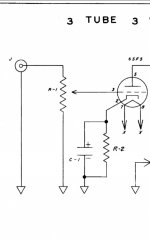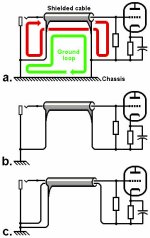I have a DIY fi 2A3 mono amp. The input R is 475k ohm. I assumed I could replace this R with a 500k ohm pot as indicated in my attachment. I installed it just with clips so far and I’m getting some nasty humming until I crank the pot wide-open. What could I be doing wrong? Thx!
Attachments
There should be a capacitor between the potentiometer’s wiper and the tube’s grid. After that capacitor, there is usually a grid stop resistor, and there should be an input current reference resistor from the grid to ground plane. That may be part of the cause of the humming symptoms.
The RC above suggested is recomendable although not mandatory.
Hum in such high impedance circuits are normal if not properly shielded. Use shielded cable and connect the metallic structure of the pot to ground. However, with pot at maximum R and without signal, some hum will ever be audible.
Hum in such high impedance circuits are normal if not properly shielded. Use shielded cable and connect the metallic structure of the pot to ground. However, with pot at maximum R and without signal, some hum will ever be audible.
The pin jack ground is isolated from chassis?What could I be doing wrong? Thx!
Then why you use this high Z of pot?
Walter
I’m just following the schematic not creating anything on my own. A couple of Japanese designs use a 100k or 250k pot.The pin jack ground is isolated from chassis?
Then why you use this high Z of pot?
Walter
When you solve the hum problem, there is another thing to fix:
The original 470k was only there to give the 6SF5 grid a DC return.
The designers expectation was that the preamp (that drove the 470k and input grid) would be much lower driving impedance (50k, 10k, etc.)
Now, you have overridden the designer's excellent input circuit.
You are using a 500k pot.
A pot has to be low enough resistance to fix the problem below:
The 6SF5 has high gain, so The Miller Effect Capacitance will cause a high frequency attenuation (high frequency rolloff),
Therefore, whenever the 500k Pot is anywhere Other Than:
Very Near it's counter-clockwise rotation, or Very Near it's clockwise rotation, the high frequencies will be rolled off.
Any iPad worth $ 0.05 has a low impedance output.
So use a 25k, 20k, or even a 10k pot.
Fix the high frequency rolloff.
Just my experience with high resistance pots that drive a large Miller Effect Capacitance.
And, a shielded cable in the input circuit can do the same thing.
The original 470k was only there to give the 6SF5 grid a DC return.
The designers expectation was that the preamp (that drove the 470k and input grid) would be much lower driving impedance (50k, 10k, etc.)
Now, you have overridden the designer's excellent input circuit.
You are using a 500k pot.
A pot has to be low enough resistance to fix the problem below:
The 6SF5 has high gain, so The Miller Effect Capacitance will cause a high frequency attenuation (high frequency rolloff),
Therefore, whenever the 500k Pot is anywhere Other Than:
Very Near it's counter-clockwise rotation, or Very Near it's clockwise rotation, the high frequencies will be rolled off.
Any iPad worth $ 0.05 has a low impedance output.
So use a 25k, 20k, or even a 10k pot.
Fix the high frequency rolloff.
Just my experience with high resistance pots that drive a large Miller Effect Capacitance.
And, a shielded cable in the input circuit can do the same thing.
The reason of my postThe 6SF5 has high gain, so The Miller Effect Capacitance will cause a high frequency attenuation (high frequency rolloff),
And the problem is higher at -6 dB of attenuation
Walter
Thanks for looking into this! I’m pretty much a novice but I do follow all safety precautions that were outlined for me in my other thread. I just use my iPad while working on my amp. I’ll being using my BlueSound Node directly into to the amp. What value pot would best be suited? Any of the ones you mentioned. DanWhen you solve the hum problem, there is another thing to fix:
The original 470k was only there to give the 6SF5 grid a DC return.
The designers expectation was that the preamp (that drove the 470k and input grid) would be much lower driving impedance (50k, 10k, etc.)
Now, you have overridden the designer's excellent input circuit.
You are using a 500k pot.
A pot has to be low enough resistance to fix the problem below:
The 6SF5 has high gain, so The Miller Effect Capacitance will cause a high frequency attenuation (high frequency rolloff),
Therefore, whenever the 500k Pot is anywhere Other Than:
Very Near it's counter-clockwise rotation, or Very Near it's clockwise rotation, the high frequencies will be rolled off.
Any iPad worth $ 0.05 has a low impedance output.
So use a 25k, 20k, or even a 10k pot.
Fix the high frequency rolloff.
Just my experience with high resistance pots that drive a large Miller Effect Capacitance.
And, a shielded cable in the input circuit can do the same thing.
I happened to have a 500k pot in my stash too. I have a MHDT DAC that has a output impedance of 32ohms and I believe the Node is 500ohms. I’ve read an amplifiers input impedance should be at least ten times the output of the source. If so a 10kohm pot should be sufficient?The reason of my post
And the problem is higher at -6 dB of attenuation
Walter
My opinion is that the value from 10k to 50 k are good
It I decide not to add the volume pot should I still lower the input impedance to what you suggest above?
A 500k Ohm grid return resistor, versus a 50k grid return resistor . . .
If a tube goes Slightly gassy, the grid voltage will change 10 times more on the 500k grid return resistor, than on the 50k grid return resistor.
Some amplifiers abuse the tubes, and dissipate more plate watts than the maximum specification.
That often the cause of grid current, and thermal run-away.
If you have old signal sources that can not drive 50k for example, then use the 500k, but with the possible effects above.
A lot of old signal sources have medium output impedances, but the coupling cap from the signal source to the amplifier input does Not provide a DC return for the grid, so the pot or the grid resistor are the only thing which provides a DC return for the grid.
Never leave a grid without a proper and appropriate DC return, a very good rule, with extremely few exceptions.
If a tube goes Slightly gassy, the grid voltage will change 10 times more on the 500k grid return resistor, than on the 50k grid return resistor.
Some amplifiers abuse the tubes, and dissipate more plate watts than the maximum specification.
That often the cause of grid current, and thermal run-away.
If you have old signal sources that can not drive 50k for example, then use the 500k, but with the possible effects above.
A lot of old signal sources have medium output impedances, but the coupling cap from the signal source to the amplifier input does Not provide a DC return for the grid, so the pot or the grid resistor are the only thing which provides a DC return for the grid.
Never leave a grid without a proper and appropriate DC return, a very good rule, with extremely few exceptions.
- Home
- Amplifiers
- Tubes / Valves
- Hum From Volume Pot

